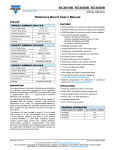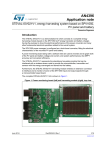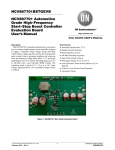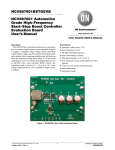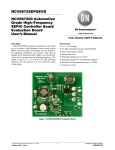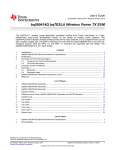Download SiC413DB SiC413 Reference Board User's Manual 4 A, 26
Transcript
SiC413DB Vishay Siliconix SiC413 Reference Board User's Manual 4 A, 26 V Integrated Synchronous Buck Regulator THE CHIP FEATURES PRODUCT SUMMARY Input Voltage Range 4.75 V to 26 V Output Voltage Range 0.6 V to 13.2 V Operating Frequency 500 kHz Continuous Output Current 4A Peak Efficiency 93 % Highside/Lowside RDS_ON 35 mΩ/19 mΩ Package SO-8 DESCRIPTION The SiC413 is an integrated, dc-to-dc power conversion solution with built-in PWM-optimized high- and low-side n-channel MOSFETs and advanced PWM controller. The SiC413 provides a quick and easy to use POL voltage regulation solution for a wide range of applications. Vishay Siliconix proprietary packaging technology is used to optimize the power stage and minimize power losses associated with parasitic impedances and switching delays. The co-packaged Gen III TrenchFET power MOSFETs deliver higher efficiency than lateral DMOS monolithic solutions. • • • • • • • • • • • 4.75 V to 26 V input voltage range Integrated PWM controller and Gen III trench MOSFETs Built-in bootstrap diode 500 kHz fixed switching frequency Internal soft start Break-before-make operation Integrated current sense Cycle by cycle overcurrent protection Output over voltage protection Thermal shutdown Quick and easy single chip converter • SO-8 package APPLICATIONS • • • • • • LCD TV, set-top box and DVD player Desktop PC and server Add-in graphic board Memory, FPGA and µP device power supplies Point of load dc-to-dc conversion Telecom and networking equipment REFERENCE BOARD PHOTOS Figure 1. Top of the PCB Document Number: 65172 S09-1350-Rev. A, 20-Jul-09 Figure 2. Bottom of the PCB www.vishay.com 1 SiC413DB Vishay Siliconix THE REFERENCE BOARD This reference board allows the end user to evaluate the SiC413 chip for its features and all functionalities. It can also be a reference design for a user’s application. SPECIFICATION Input voltage (V): 4.75 to 24 Output voltage (V): 0.6 to 12.0 Output current (A): 0 to 4 Notes: • This board is, by default, preset to 3.3 V output with 12 V input • This board can be set to any output voltage between 0.6 V and 12 V, and any input voltage between 4.75 V and 24 V. For a specific input/output voltage combination, the values of inductor and compensation network may need to be modified and the output capacitors may need an increase or decrease. INPUT CAPACITORS The input capacitors are chosen as a combination of electrolytic and ceramics so that the capacitance, the rms current, the ESR, the input voltage ripple and the cost can be all fairly satisfied. For a combination of high voltage input and low voltage output (low duty cycle), the electrolytic capacitors (C1) may not be required. INDUCTORS If off-the-shelf inductors are to be used, then their DCR and saturation current parameters are the key besides their inductance values. The DCR causes an I2R loss, which will decrease the system efficiency and generate heat on the board. The saturation current has to be higher than the maximum output current plus ripple current. In over current condition the inductor current may be drastically high. All these need to be put into consideration when selecting the inductor. On this board Vishay IHLP4040DZ series inductors are used to meet cost requirement and get better efficiency. OUTPUT CAPACITORS Voltage, ESR, rms current capability and capacitance are essential elements to consider when choosing output capacitors. The ESR and capacitance affect the output voltage ripple, transient response and system stability. The rms current capability determines the capacitor power dissipation and life time. To meet all the 4 element requirements, combination of ceramics and tantalum can be used. CONNECTION AND SIGNAL/TEST POINTS Power sockets VIN (J1), GND (J3): Input voltage source with VIN to be positive. Connect to a 4.75 V to 24 V source that powers SiC413. VOUT (J9), GND (J13): Output voltage with VOUT to be positive. Connect to a load that draws less than 4 A current. Signal and test leads VIN (J2), GND (J5): Intput voltage sense pins with VIN to be positive. Connect to a volt meter or an oscilloscope probe if display or waveform is needed. VOUT (J11), GND (J14): Output voltage sense pins with VOUT to be positive. Connect to a volt meter or an oscilloscope probe if display or waveform is needed. VCTRL (J6), LDTRG (J8), GND (J7): Load step control signal input. Connect VCTRL and GND to a power source, VEXT, which supplies enough voltage to generate the load step needed. Connect LDTRG and GND to a pulse generater that creates the MOSFET on/off signal for the load step. EN: SiC413 enable signal input. To enable the system leave this point open, otherwise connect it to any GND. 0.3 100 90 80 70 0.1 Efficiency (%) Output Voltage Variation (%) 0.2 0 - 0.1 60 50 40 30 20 - 0.2 10 - 0.3 0.0 0.5 1.0 1.5 2.0 2.5 3.0 3.5 Load Current (A) Figure 3. 12 V - 3.3 V Load Regulation www.vishay.com 2 4.0 0 0.0 0.5 1.0 1.5 2.0 2.5 3.0 3.5 4.0 Load Current (A) Figure 4. 12 V - 3.3 V Efficiency Document Number: 65172 S09-1350-Rev. A, 20-Jul-09 SiC413DB Vishay Siliconix SET UP LOAD STEP The hardware to test transient response is included in the board, which allows users to see how the transient response performs. The setup steps are: 1. Decide what load step is wanted, then based on the output voltage calculate the external voltage VEXT that will be connected between VCTRL and GND. For example, a load step of 2 A between 0.5 A (I1) and 2.5 A (I2) is required and the output voltage is 3.3 V. VEXT = VO - (I2 - I1) * 3.01 Ω = VO - (2.5 A - 0.5 A) * 3.01 Ω = - 2.72 V. Preset a DC source voltage to VEXT = 2.72 V (current capability around 1 A) and connect it to the board with positive side to GND and negative side to VCTRL (if VEXT is a positive value, then connect the DC source positive to VCTRL and negative to GND). 2. Preset a waveform from a function generator using the following parameters and set its output to OFF (refer to the specific function generator manual for its setup): Shape: square Freqency: 50 Hz or whatever is required Duty cycle: 1 % to 2 % or whatever is required Amplitude: -12 V low level and + 10 V high level Rising time and falling time: 1 µs or whatever is required. 3. Connect the function generator output positive to LDTRG and negative to GND. 4. Preset the current of an electronic load to I1 and turn it on. 5. Set up an oscilloscope using the following parameters. Channel 1 for probing output voltage: AC coupled, 20 mV/div to 50 mV/div, 100 mV offset, or whatever is required . Channel 2 for probling the current on the 3.01 Ω resistor (R2) (needs to be an isolated probe): DC coupled, 3 V/div (corresponds to 1 A/div) for IO < 2.5 A or 5 V/div (corresponds to 1.661 A/div) for IO > 2.5 A. Time base: 100 µs/div Bandwidth: 20 MHz 6. Connect oscilloscope channel 1 probe positive to VOUT (J11) and negative to GND (J14), and channel 2 probe positive to VOUT (J11) and negative to Q1 DRAIN. 7. Turn on the system power. Output voltage should be shown on the electronic load with current of I1. 8. Turn on the power source for VEXT. 9. Set the function generator output to be ON. The transient response waveforms should be seen on the oscilloscope. 10. If needed, re-adjust the trigger waveform’s rising and falling time on the function generator so that the current slew rate is satisfied (the current slew rate can be seen on oscilloscope channel 2 waveform by setting the time base to 1 µs or 500 ns). 11. To change load step, decrease or increase the value of VEXT. 12. To cease transient response test, simply set the function generator output to off, turn off the power source for VEXT, and then shut down the system power. CHANGE OUTPUT VOLTAGE If, at any time, different output voltage is needed, then simply change the value of R9 based on the following formula: R9 = R7/(VO/VREF - 1) = 10K/(VO/0.6 - 1) COMP Output Voltage Inductor Current IL Figure 5. An Example of Load Step Waveforms Document Number: 65172 S09-1350-Rev. A, 20-Jul-09 www.vishay.com 3 SiC413DB Vishay Siliconix PCB LAYOUT Figure 6. Top Figure 7. Inner Layer 1 www.vishay.com 4 Figure 8. Inner Layer 2 Figure 9. Bottom Layer Document Number: 65172 S09-1350-Rev. A, 20-Jul-09 1 J6 VCTL J14 VO_GND J13 VO_GND J11 VO 1 1 1 J8 LDTRG J9 VO 1 J7 GND 1 1 C11 22 µF 1 1 1 J5 VIN_GND J3 VIN_GND J2 VIN VO V 1 1 1 R9 2K21 R7 10K R2 3R01 C4 10 µF 1 C16 C C15 3.3 nF Si4812BDY Q1 C3 10 µF M2 Mounting Hole C2 10 µF M1 Mounting Hole 1 C130.1 µF R3 100K + C1 150 µF J12 VO Check Pin C12 22 µF VIN 1 1 C7 4.7 µF 1 1 M4 Mounting Hole C20 10 µF R11 20K C8 0.1 µF C19 C17 C18 100 µF 100 µF 100 µF + + + C6 0.01 µF M3 Mounting Hole C5 0.1 µF R9 open 12K 10K 6K65 4K99 3K16 2K21 1K37 523R GND VIN VREG FB U1SiC413 L1 4.7 µH 5 6 7 8 VO 0.6 V 1.100 V 1.200 V 1.502 V 1.802 V 2.499 V 3.315 V 4.980 V 12.072 V VSW BOOT EN COMP R1 100K 4 3 2 1 EN J4 EN 1 1 GND GND GND GND 5 4 3 2 C21 C R8 R C14 0.1 µF R5 0R VSW 1 C9 100 pF V J10 VSW Check Pin R6 3K01 C10 10 nF GND GND GND GND Document Number: 65172 S09-1350-Rev. A, 20-Jul-09 2 3 4 5 J1 VIN R10 750K SiC413DB Vishay Siliconix SCHEMATIC www.vishay.com 5 SiC413DB Vishay Siliconix BILL OF MATERIAL Item Qty Reference Value Voltage PCB Footprint Part Number Manufacturer 1 1 C1 150 µF 35 V D8X11.5-D0.6X3.5 EEU-FM1V151 Panasonic 2 3 C2, C3, C4 10 µF 25 V SM/C_1210 TMK325B7106MN-T Taiyo Yuden 3 4 C5, C8, C13, C14 0.1 µF 50 V SM/C_0603 VJ0603Y104KXACW1BC Vishay 4 1 C6 0.01 µF 50 V SM/C_0402 VJ0402Y103KXACW1BC Vishay 5 1 C7 4.7 µF 10 V SM/C_0805 LMK212B7475KG-T Murata/Taiyo Yuden 6 1 C9 100 pF 50 V SM/C_0603 VJ0603Y101KXACW1BC Vishay 7 1 C10 10 nF 50 V SM/C_0603 VJ0603Y103KXACW1BC Vishay 8 2 C11, C12 22 µF 16 V SM/C_1210 GRM32ER71C226ME18L TAIYO YUDEN 9 1 C15 3.3 nF 50 V SM/C_0603 VJ0603Y332KXACW1BC Vishay 10 2 C16, C21 Not populated 50 V SM/C_0603 11 3 C17, C18, C19 100 µF 20 V 595D-D 595D107X9020D2T 12 1 C20 10 µF 16 V 13 1 J1 VIN 14 1 J2 15 1 J3 Vishay Vishay SM/C_1206 C3216X7R1C106M TDK SOLDER-BANANA 575-6 Keystone VIN Probe Hook 1540-2 Keystone VIN_GND SOLDER-BANANA 575-6 Keystone 16 1 J4 EN Probe Hook 1540-2 Keystone 17 1 J5 VIN_GND Probe Hook 1540-2 Keystone 18 1 J6 VCTL Probe Hook 1540-2 Keystone 19 1 J7 GND Probe Hook 1540-2 Keystone 20 1 J8 LDTRG Probe Hook 1540-2 Keystone 21 1 J9 VO SOLDER-BANANA 575-6 Keystone 22 1 J10 VSW check pin LECROY PROBE PIN PK007-015 LeCroy 23 1 J11 VO Probe Hook 1540-2 Keystone 24 1 J12 Vo check pin LECROY PROBE PIN PK007-015 LeCroy 25 1 J13 VO_GND SOLDER-BANANA 575-6 Keystone 26 1 J14 VO_GND Probe Hook 1540-2 Keystone 27 1 L1 4.7 µH IHLP4040 IHLP4040DZER4R7M01 Vishay 28 4 M1, M2, M3, M4 Mounting hole 29 1 Q1 Si4812BDY 30 2 R1,R3 31 1 R2 32 1 R5 0R 50 V SM/C_0603 CRCW06030000FKEA Vishay 33 1 R6 3K01 50 V SM/C_0603 CRCW06033K01FKEA Vishay CRCW060310K0FKEA Vishay STACKING SPACER 8834 Keystone 30 V SO-8 Si4812BDY Vishay 100K 50 V SM/C_0603 CRCW0603100KFKEA Vishay 3R01 200 V C_2512 CRCW25123R01FKTA Vishay 34 1 R7 10K 50 V SM/C_0603 35 1 R8 R 50 V SM/C_0603 Vishay 36 1 R9 2K21 50 V SM/C_0603 CRCW06032K21FKEA Vishay 37 1 R10 750K 50 V SM/C_0603 CRCW0603750KFKEA Vishay 38 1 R11 20K 50 V SM/C_0603 CRCW060320K0FKEA Vishay 39 1 U1 SiC413 SO-8 SiC413 Vishay Vishay Siliconix maintains worldwide manufacturing capability. Products may be manufactured at one of several qualified locations. Reliability data for Silicon Technology and Package Reliability represent a composite of all qualified locations. For related documents such as package/tape drawings, part marking, and reliability data, see www.vishay.com/ppg?65172. www.vishay.com 6 Document Number: 65172 S09-1350-Rev. A, 20-Jul-09






